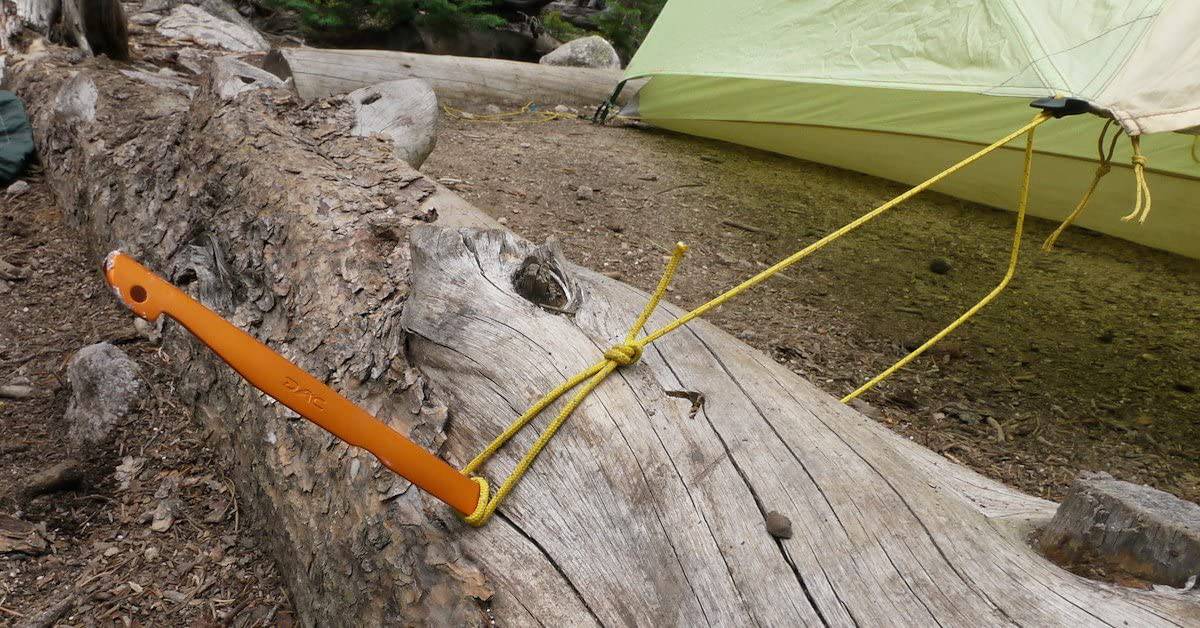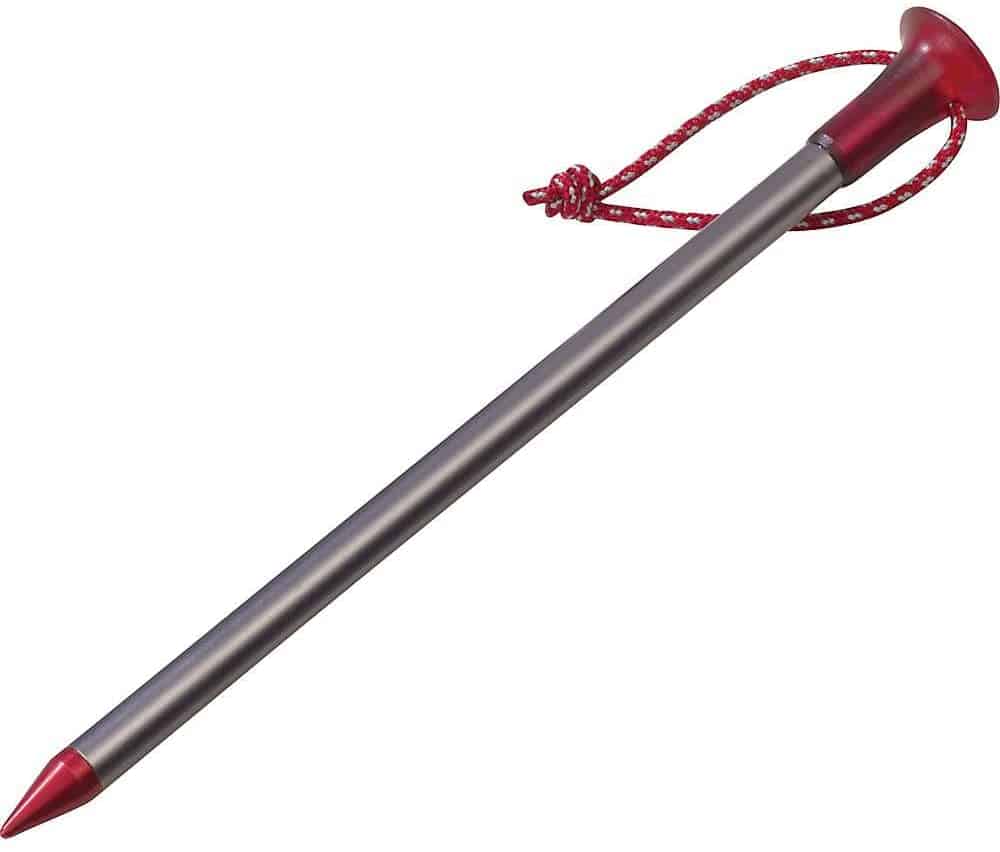When you’re packing for a camping trip, your tent stakes might not be at the top of your list of concerns. But, without a good set of tent pegs, it’s hard to anchor your shelter down in a storm.
In fact, stakes are one of the most overlooked pieces of camping gear, despite their outsized importance and impact on our backpacking or camping experience. That being said, there are literally hundreds of different models of tent pegs out there, so it can be difficult to know which ones are best for you.
To get you started down the right path, here are our reviews of the top tent stakes on the market today, plus a guide to finding the right set for your needs.
#1 – MSR Mini Groundhog
The MSR Mini Groundhog is an award-winning tent stake that’s designed for frequent backpacking trips in areas with particularly firm ground.
The stakes are made with 7000-series aluminum, which is durable enough for regular use.
They have a Y-beam construction that can get good purchase in medium or firm soil, even in high winds.
These stakes are also just 6 inches (15cm) long and they weigh only 0.35oz (10g), so they’re compact enough for extended backpacking trips.
I’ve personally used these stakes for years on expeditions all over the world. I particularly like that they have an attached pull loop which makes them easy to remove from the ground each morning.
pros
- Compact size for packing
- Very lightweight for a Y-beam stake
- Built-in pull loop for easy removal each morning
- Durable 7000-series aluminum construction
cons
- Fairly expensive for an aluminum stake
#2 – DAC V-Best
The DAC V-Best is a strong stake crafted specifically for rocky ground. They are built using a high-strength aluminum alloy that’s 20% stronger than aerospace-grade aluminum and more than three times stronger than the materials normally found in tent stakes.
This stake is available in four different sizes, the lightest of which is just 0.40oz (11.3g). They have particularly good holding power because of their V-shape and large width, which provides more surface area than hook-shaped pegs.
Additionally, the DAC V-Best is made with a solid striking surface at the top that is capable of dispersing force better throughout the peg. This makes them less likely to bend or warp when setting them in very rocky soil.
pros
- Made with a super-strong aluminum alloy
- Multiple sizes available for different budgets/weight savings needs
- Durable strike head reduces the likelihood of bending and warping
cons
- Not ideal for very sandy ground – best for firm and rocky soil
#3 – MSR Carbon Core
The MSR Carbon Core is one of the world’s only full-strength ultralight tent pegs. It has a unique design that incorporates an aluminum shell for durability and a carbon-fiber core for weight savings. Due to its aluminum shell, these stakes are surprisingly strong for something that’s so lightweight.
These stakes also have a sharp point, which makes it easier for them to drive deeper into the ground to anchor down your tent in high winds. Finally, they have an integrated pull loop that can help reduce any frustration with removing the stakes from the ground each morning.
As far as ultralight stakes go, the Carbon Core are some of my favorites. I’ve used them on quite a few lightweight backpacking trips and am always pleasantly surprised at how strong they are for their weight.
NOTE: Using any type of lightweight stake requires that you treat them with care to avoid damage. Unlike steel stakes, these pegs are not designed to be hit with a massive hammer or pushed into the ground with your foot. When using the Carbon Core, use a small rock to hammer them into the soil to prevent them from breaking.
pros
- Very lightweight (just 0.2oz/5.7g)
- One of the few full-strength ultralight tent stakes on the market
- Integrated pull loop for easy removal at the end of a trip
cons
- Very expensive
- Need to be treated with care and set properly to avoid breaking
The Vargo Shepherd’s Hook is a J-shaped tent peg for lightweight backpackers. It is built with a single piece of high-grade titanium that is simultaneously lightweight and durable.
Thanks to the stake’s shape, they are easy to drive into very firm ground. However, because they are so thin (just 0.14in/3.55mm in diameter), we recommend using a rock to hammer in these stakes, instead of pushing them in with your foot.
We particularly like these stakes because they have bright orange coated heads that are very easy to spot on the ground when you’re packing up your tent. Additionally, the Vargo Shepherd’s Hook weighs just 0.3oz (8g) each, so they’re a good compromise between pricier carbon pegs and heavier aluminum alternatives.
pros
- Easy to drive into firm ground
- Bright orange head makes it harder to lose them as you pack up your tent
- Very lightweight and compact
- Reasonably priced for lightweight stakes
cons
- Very thin diameter requires care not to bend or break when setting in rocky soil
#5 – MSR Groundhog
The MSR Groundhog is the Mini Groundhog’s bigger sibling. These are MSR’s classic Y-beam stake and they are designed to work well in a variety of different soil conditions while still being quite affordable.
Although they are slightly longer (7.5in/19cm) than some ultralight options, these stakes tip the scales at just 0.46oz (13g). However, this added length and surface area gives them extra holding power in softer soil and high winds.
These stakes also feature a reflective pull loop that makes them easy to take out of the ground each morning.
Due to their extra length and ample durability, the Groundhog is my go-to stake for use in extremely windy environments, especially if I know that the ground is loose or especially rocky in my camping destination.
pros
- Good holding power in a variety of different soil types, especially loose and rocky terrain
- More affordable than some lightweight options
- Made with durable 7000-series aluminum
cons
- Less compact and slightly heavier than ultralight options
How To Choose Tent Stakes
With so many different tent stakes to choose from, it’s important that you know precisely what to look for as you’re shopping around. Here are some of the most important features to keep in mind as you make your decision.
Tent Stake Shape
Tent pegs come in multiple different shapes, each with their own advantages and disadvantages. This is what you need to know about the various shapes of tent stakes:
- V-Stakes. V-stakes are particularly useful for camping locations that have very rocky ground. This is because they provide quite a lot of surface area, which increases their overall holding power and helps them anchor your tent. However, they are usually a bit heavier than other options.
- Y-Stakes. Y-stakes are like V-stakes, but they have one extra face, which creates even more surface area and holding power in loose soil. That being said, this extra surface area means that they can be a bit trickier to place in rocky terrain.
- Shepherd’s Hooks. The final major type of tent peg is a “shepherd’s hook.” As the name suggests, these are shaped like a hook with a thin point at one end that is easy to drive into the ground. This type of peg is very common and is often quite affordable. But, due to their slender shape, shepherd’s hooks tend to bend and break fairly easily.
Tent Stake Material
Modern tent pegs are made using four basic materials, all of which affect both the performance and the price of a given model. These are your different options:
- Steel. Steel is most commonly used for stakes that are designed for heavy-duty use, such as with canvas tents or on car camping adventures. The main drawback to these pegs, though, is that they are very heavy and generally impractical for use while backpacking.
- Aluminum. Aluminum is likely the most commonly used material in the manufacturing of tent stakes. This is because it offers a good mix of durability and weight savings. It’s also fairly inexpensive when compared to some other options. But, aluminum stakes do bend fairly easily when pushed into rocky ground with your foot.
- Carbon Fiber. Carbon fiber is one of the newest tent stake materials but it is becoming more popular each year because it is very lightweight. However, despite its high holding power, carbon fiber can break very easily when slammed into rocks, so anyone using stakes made with material needs to take care when placing them into the ground.
- Titanium. Titanium is one of the strongest metals out there. But, where it really shines is in terms of its light weight. Pound for pound, titanium is stronger than aluminum, so these stakes are often some of the lightest on the market. Of course, these weight savings generally correlate with a higher overall price, but you often get quite a good value in terms of overall quality with a titanium stake.
The Verdict
Tent stakes are a small, but essential part of your camping gear. Although they might seem simple, there’s a lot that goes into designing a quality tent peg and even more that goes into finding the right one for your needs.
- Tint Colors Explained For Polarized Sunglasses - November 19, 2022
- Top 4 Best Portable Camping Showers of 2022 - November 19, 2022
- How to Choose Water Shoes & What to Look For - November 18, 2022











